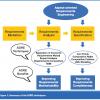|
|
Managing Your Analysis Debt What is your project's analysis debt load? What's the difference between good and bad analysis debt? What are causes and remedies for such debt? Mary Gorman and Ellen Gottesdiener explore the concept of analysis debt and consider strategies for prudent investing.
|
|
|
|
The Whos and Wheres of Stakeholder Requirements Whether you're working on a collocated or a distributed team, it's important to take stakeholder requirements into account: "Who" are they and "where" are they located? In this article, Mary Gorman offers some tips to help you narrow the gap between thinking and acting globally and locally.
|
|
|
|
How Agile Practices Reduce the Top 5 Requirements Risks Requirements risks are among the most insidious risks threatening software projects. Whether it is having unclear requirements, lack of customer involvement in requirements development, or defective requirements, these troubles are a major culprit in projects that go awry. As requirements expert and agile coach Ellen Gottesdiener explains, agile practice can go a long way in mitigating the top five requirements risks.
|
|
|
|
How Agile Practices Reduce Requirements Risks Requirements risks are among the most insidious risks threatening software projects. Whether it is having unclear requirements, lack of customer involvement in requirements development, or defective requirements, these troubles are a major culprit in projects that go awry. As requirements expert and agile coach Ellen Gottesdiener explains, agile practice can go a long way in mitigating those risks.
|
|
 |
Building a Foundation for Structured Requirements: Aspect-Oriented Requirements Engineering Explained (Part 2) Aspect-oriented requirements engineering (AORE) is a new methodology that can help us to further improve the analysis, structure, and cost of development of software requirements. The second part of this two-part series focuses on the AORE specification techniques.
|
|
 |
Building a Foundation for Structured Requirements: Aspect-Oriented Engineering Explained (Part 1) Aspect-oriented requirements engineering (AORE) is a new methodology that can help us improve the analysis, structure, and cost of development of software requirements. AORE does not replace but rather complements any of the existing requirements methodologies. This two-part paper explains to software practitioners the AORE concept, illustrates how it can be applied on software projects, and discusses the benefits of AORE. Part I focuses on the AORE analysis techniques.
|
|
|
|
Bringing Your Requirements Discussions Down to Earth Trying to communicate with businesspeople about requirements can make you feel like you're from another planet. Using concrete examples expressed as storytests to drive the development of a system can help bring you back into the same orbit. Discover ways to introduce this process on your next project.
|
|
|
|
Information Gathering If your customer interview questions focus too narrowly on a problem that must be solved, you run the risk of missing information that could be critical to a successful outcome. In this column, Naomi Karten says playing detective improves your ability to gather information. To improve the odds of success, it's important to ask questions from multiple perspectives—and to pay attention not only to the customers' response, but to how they say it as well.
|
|
|
|
Quality Interactions: Bulding Effective Working Relationships As software professionals, we all care about quality. We focus our efforts on building quality into the code and testing to assess quality and find errors before our customers do. However, there is an important element of quality that comes before all that and is critical to delivering reliable software: quality working relationships and quality interactions. Esther Derby covers pragmatic strategies for building, strengthening, and maintaining working relationships with all stakeholders-managers, customers, team members, and peers. The first step is to build a foundation of trust and respect. Then, we must focus on interests rather than positions and seek joint solutions to problems. We should use the richest communication channel available for our interactions and make a generous interpretation of others’ actions.
|
Esther Derby, Esther Derby Associates Inc
|
|
|
The Peculiar Nature of Requirements Turn to The Last Word, where software professionals who care about quality give you their opinions on hot topics. This month, Karl Wiegers shares some common misperceptions about requirements.
|
|

